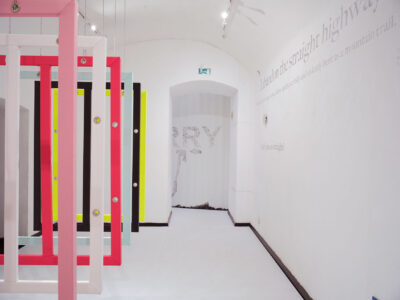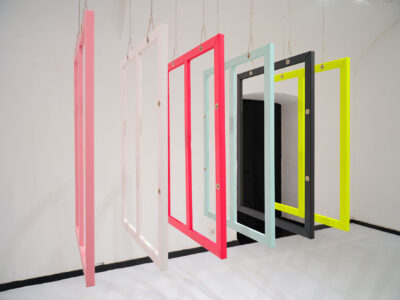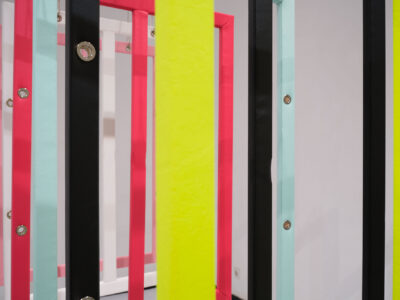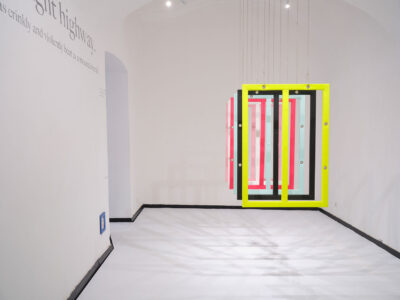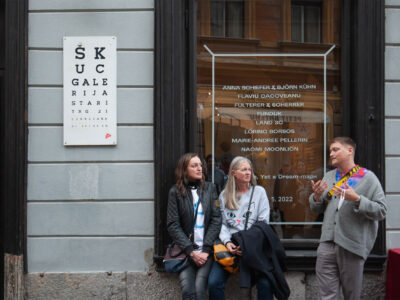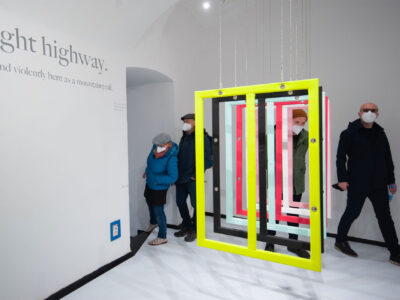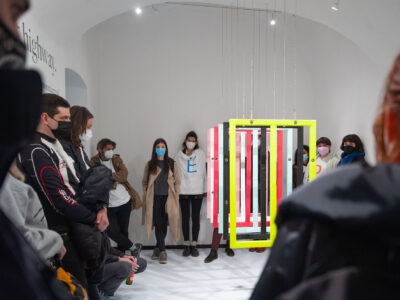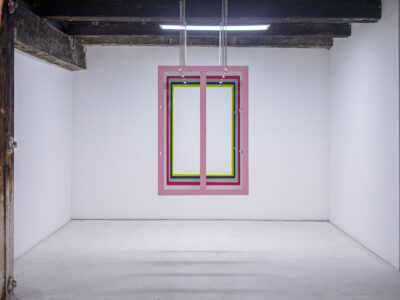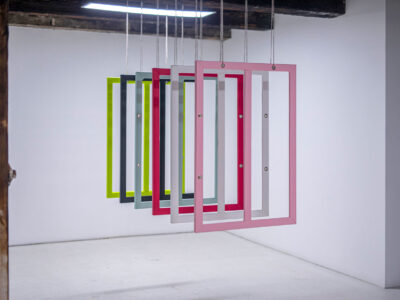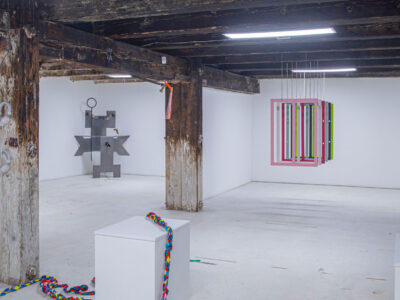Artists: Anna Schiefer, Flaviu Cacoveanu, Fulterer & Scherrer, Funduk, LAND 3C, Lőrinc Borsos, Marie- Andrée Pellerin, Naomi Moonlion
Curator: Maximilian Lehner
“What it is, Yet a Dream-map” is an international group exhibition featuring immersive sound and visual installations as well as speculative art projects in the fields of performing and media art. Departing from a poem by the feminist author Adrienne Rich, all works deal with alternative modes of thinking physicality – objects, spaces, sounds. They do so by playing with the formation of sculptural objects, queering space, imagining the physical shape of the political, or creating alternative perceptions of cities and states. The exhibition is an invitation for utopian thinking, taking art as the basis to sketch alternatives to established modes of thinking. The artworks from different disciplines offer an entry point, not in showing concrete examples of possible futures, but in relating to current problems and crises of our world, and serving as a “dream-map” to alternatives.
Neon, Dark, Glitter? Is it cosy and soft or solid, cold? How does it look and feel and sound? The different, the other, the future, the alternative, the non-conforming, the speculative, the dream, the utopia. Is it only something we didn’t recognize yet? How do you approach a thought different from how you are used to conceive things?
I had this idea for an exhibition in my mind, the concept was there. I probably lost it—or even failed to draft it in the first place, I might have only dreamed it. I thought through the possible means of approaching physical qualities in a radical new way. Spaces, bodies, objects, sounds. How to visualize, spatialize, manifest something as an alternative? How to inscribe traumatic pasts and burdened histories in a way that is not only an a.empt to avoid future failure? How to think encounters and traces of difference without the negativity that sticks to anything off the normative?
Within the field of Queer Studies, there is a drive to do so. As Jack Halberstam wrote: “We need to craft a queer agenda that works cooperatively with the many other heads of the monstrous entity that opposes global capitalism, and to define queerness as a mode of crafting alternatives with others.”1 Although triggered by a history of neglect and stigmatization, other than focusing on concrete forms of discrimination, this queerness as a form of alternative, non-conforming, can be a utopia. But, “Queerness is not yet here. Queerness is an ideality.”2
Further away from modes of critical thought, I suddenly find myself with a poem, Dreamwood by Adrienne Rich. The thought of a radical dream to be found in something as ordinary and banal as in the figure of the wood a piece of furniture is made of soothes me. In the poem, where the exhibition title stems from, a whole landscape is uncovered in the veiny, carved old wood. One might rather ascribe this imaginative perception where there is nothing to see to a child. Because we tend to see walls, state boundaries, a physical shape, socio-political factors, three dimensions, rules and laws that delineate how we use places. All these factors are questioned and criticized, maybe changed.
But how to really alter the ways we think about boundaries or shapes? “Our a.ention is saturated with all the knowledge of what we can no longer imagine.”3 In a complex pa.ern of critique, one might get lost, sometimes contradictory and opposing forces are decisive of what stance we take. But in all this, again, a sense of difference is lost. That there could be an alternative. I was hoping for some hint from theories, maybe some utopian impulse from alternative spaces. But anywhere there is an urge to create something different, the utopia fills very concrete needs. The ideas are shaped by forces that we criticize because they impose neoliberal standards, support economization of all spheres, because they marginalize different forms of living or exclude those outside a fictional norm, because they force their views and standards on others. It seems, even fabulation and speculative thinking tend to be controlled by these imageries we oppose to.
All the seemingly normalized ways of seeing and thinking offer margins for extending them, for perceiving and conceiving them in different, non-conforming ways. The old piece of furniture from the poem points to that kind perception. The exhibition is therefore narrated in a space without a particular order. When walking through the space, you walk between utopia, abstraction, and imagination – in plain sight, the weight of the past.
I felt that there’s a way of approaching space and sound differently in the narrative installations of this exhibition, suddenly giving physicality to something that is described as not fi]ng our usual imageries of the world; A fictitious entity that we did not know before, which we cannot assign to anything familiar. We get a glimpse on how subcultural cues lead you to imagine something new. The combination of signs, the complete void, spatial distribution, or a political signifier that becomes a space, a sculpture, an object, an instrument, a map. These ideas present in the exhibition aim to something in-between, a space, an entity that emerges in relations or differences and can therefore constitute something radically new, guides us through all the positions of this exhibition.
This calls for a shift of perspective, against the idea that the concepts of things and how to group them prefigure our possibilities of what to see, what to describe, name, and feel. “Today we are literate, but we cannot read between the lines or beyond a literality that falls upon us with all the weight of insulting obviousness. There is no room for strangeness.” How to imagine all physicality as strangeness?4 I thought of it as an experiment: what happens, if we take this different point of departure? Where to find these radical new spaces and objects?
I’m back with the poem, and maybe a hint on understanding what these works of art in the exhibition could do. They don’t need to craft a new way of perceiving the world, we don’t need to infer from a concrete materiality to a new image of the world. But it could be similar to the figure of the wood, a dream-map: “It would be the map […] / by which she would recognize that poetry / isn’t revolution but a way of knowing / why it must come.”5
Maximilian Lehner
1) Judith [Jack] Halberstam, 2008. The Anti-Social Turn in Queer Studies, GJSS 5 (2), p. 154.
2) José Esteban Muñoz, 2009. Cruising Utopia: The Then and There of Queer Futurity. New York: NYU Press, p. 1.
3) Marina Garcés, 2022. Critical imagination, Artnodes 29 (January 2022), p. 7.
4) Ibid.
5) Adrienne Rich, 1987. Dreamwood. In: Collected Poems: 1950-2012, New York: W. W. Norton & Co., 2016.
